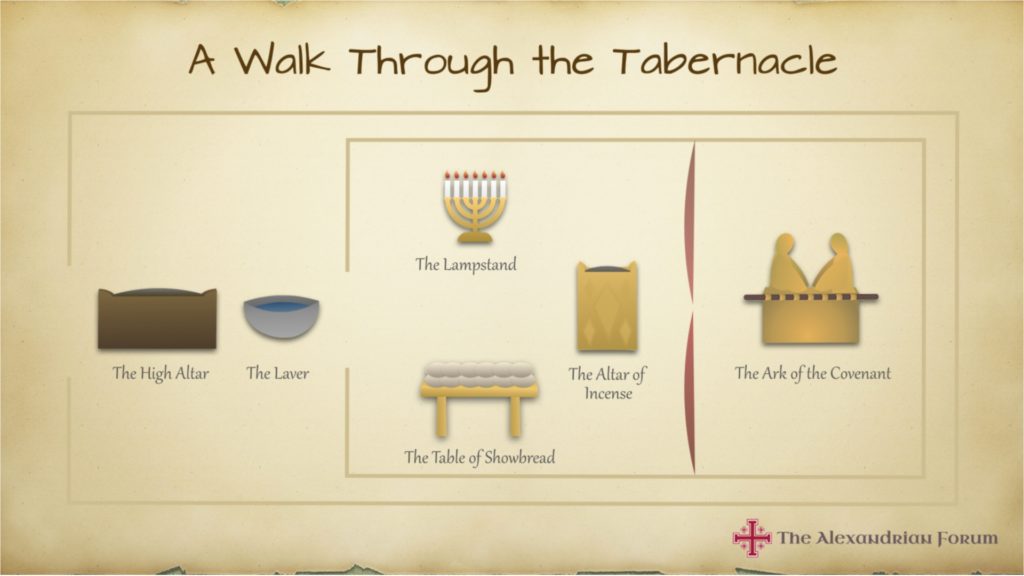Hey Church!

- Altar: Bloody sacrifice. Before entry to God’s holy presence, death must occur.
- Laver: Wash before entering the Tabernacle.
- Door: East-facing entryway to the Holy Place.
- Lampstand: 7 branches, Tree of Life, dwell in light.
- Table of Shewbread: God’s provision, 12 loaves representing the 12 tribes of Israel.
- Altar of Incense: High Priest offered intercessory prayers.
- Veil: Embroidered with cherubim, guarding entry to the Holy of Holies (the Most Holy Place). It separates man from God’s presence.
- Ark of the Covenant: God’s presence, two angels on either side, looking downward towards the mercy seat. Contained emblems of death and resurrection (manna, Aaron’s budding rod, and the two stone tablets).
John’s writings in his Gospel and Revelation present Jesus as the new and better Tabernacle. He shows us how all of the features of worship in the Old Testament were what Hebrews 10 calls “but a shadow” of the reality that would be revealed in the person and work of Jesus. John 1:14 and Revelation 21:3 are like thematic bookends, suggesting that everything he wrote was to reveal how Jesus is now the place where God dwells with man.
John 1:14 “And the Word became flesh and dwelt (literally, “tabernacled”) among us, and we have seen his glory, glory as of the only Son from the Father, full of grace and truth.”
Rev. 21:3 “And I heard a loud voice from the throne saying, “Behold, the dwelling place (literally, “tabernacle”) of God is with man. He will dwell with them, and they will be his people, and God himself will be with them as their God.”
In John’s Gospel, Jesus proclaims Himself to be the:
- Altar: (Jn. 3) The once-for-all Lamb of Sacrifice, by whose blood we have entry to the presence of God.
- Laver: (Jn. 4) The living water, by which we will never thirst again.
- Door: (Jn. 10) “I am the door.”
- Lampstand: (Jn. 8-9) Jesus gives sight to the blind and identifies Himself as “the light of the world.”
- Table of Shewbread: (Jn. 6) Jesus feeds 5,000, 12 baskets left over, identifies Himself as “the bread of life.”
- Altar of Incense: (Jn. 17) Jesus’ High Priestly prayer
- Veil: (Jn. 18-19) the veil of Jesus’ body torn, removing the barrier between man and God.
- Ark of the Covenant: (Jn. 20:12) John describes what Mary and the disciples saw in Jesus’ empty tomb as a mirror image of the ark of the covenant. Where Jesus’ body had been laid was like the mercy seat where atonement was made, between two angels, one at the foot and one at the head, and His garments folded and left there, as would have been the custom of Israel’s high priest. The Ark contained emblems of death and resurrection: manna, Aaron’s rod, and the two stone tablets. But Jesus’ empty tomb opened the way to a new era where His Law would no longer be inscribed on stone tablets but indelibly written on the hearts and minds of people. Just as the prophet Ezekiel said: “And I will give you a new heart, and a new spirit I will put within you. And I will remove the heart of stone from your flesh and give you a heart of flesh. And I will put my Spirit within you, and cause you to walk in my statutes and be careful to obey my rules.” (Ezekiel 36:26-27)
All of this points to the beautiful truth that when we worship God, we do so in Jesus. Because He has taken the curse of the Law upon Himself, fulfilling it completely, we who put our faith in Him are recipients of a new and better law, the law of grace. Open your hands and hearts to this “good word” over the weekend and then come ready to celebrate and give thanks for all that He is and all that He has done for you:
“Therefore, since we have a great high priest who has ascended into heaven, Jesus the Son of God, let us hold firmly to the faith we profess. For we do not have a high priest who is unable to empathize with our weaknesses, but we have one who has been tempted in every way, just as we are—yet he did not sin. 16 Let us then approach God’s throne of grace with confidence, so that we may receive mercy and find grace to help us in our time of need.” (Hebrews 4:14-16)
Your brother,
Ryan

